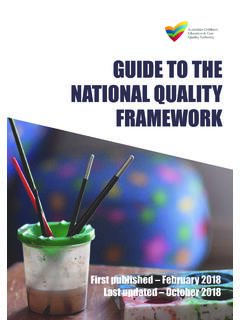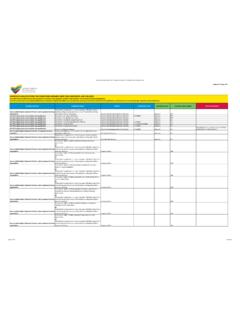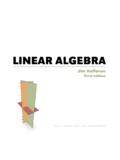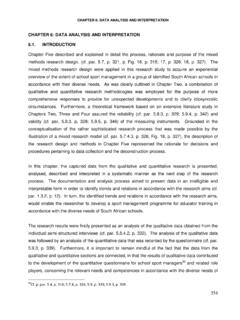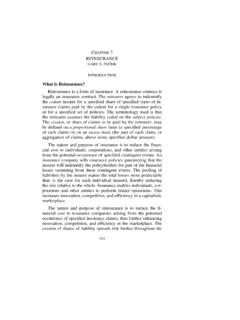Transcription of Guide to the National Quality Framework: Chapter 3 - ACECQA
1 3. National Quality STANDARD AND assessment AND RATING Guide to the National Quality StandardAssessment and rating processNational Quality Standard and assessment and Rating | National Quality Standard and assessment and Rating | 86 ICONS LEGENDO bserveAuthorised officers will observe what children, families, educators, co-ordinators and staff members are doing (for example, engaging in caring, friendly and respectful interactions).SightAuthorised officers will sight documentation provided as evidence to support particular practices at the service (for example, records of attendance, enrolment records, policies and procedures, meeting minutes, safety checklists, newsletters, photos, collections of children s work and documentation of child assessments or evaluations).Family day care serviceAn education and care service that is delivered through the use of two or more educators to provide education and care to children and operates from two or more serviceAn education and care service other than a family day care service which includes most long day care, preschool and outside school hours care services that are delivered at a Law and RegulationsSections of the Education and Care Services National Law ( National Law) or regulations from the Education and Care Services National Regulations ( National Regulations).
2 OffenceOffences against the National Law that attract a penalty, for example a fine. WATASNSWSAQLDNTVICACTS tate iconsInformation that is specific to a state or officers will discuss why and how particular practices occur at the service, with the approved provider, nominated supervisor, educators, co-ordinators, family day care educators, assistants or staff to threeChildren birth to three years of age childrenIncludes children attending school in the year before grade 1, and Quality Standard and assessment and Rating | 87 National Quality STANDARD AND assessment AND RATING1. Introduction 882. Guide to the National Quality Standard 92 Quality Area 1: Educational program and practice 93 Standard : Program 96 Standard : Practice 110 Standard : assessment and planning 123 Quality Area 2: Children s health and safety 138 Standard : Health 140 Standard : Safety 160 Quality Area 3: Physical environment 176 Standard : Design 178 Standard : Use 188 Quality Area 4: Staffing arrangements 202 Standard : Staffing arrangements 203 Standard : Professionalism 215 Quality Area 5: Relationships with children 224 Standard : Relationships between educators and children 226 Standard : Relationships between children 238 Quality Area 6: Collaborative partnerships with families and communities 248 Standard : Supportive relationships with families 250 Standard : Collaborative partnerships 265 Quality Area 7.
3 Governance and leadership 278 Standard : Governance 280 Standard : Leadership 2983. assessment and rating process 3141. Introduction 3142. Self- assessment and Quality improvement planning 3163. The rating system 3204. How is an assessment and rating visit conducted? 3265. Exceeding NQS theme guidance 3316. Making minor adjustments 3367. Waivers 3408. Evidence of non-compliance 3409. Significant Improvement Required 34010. Reassessment and re-rating at request of the approved provider 34411. First tier review 34612. Second tier review 351 CONTENTSN ational Quality Standard and assessment and Rating | IntroductionNational Quality Standard and assessment and Rating | Introduction88 INTRODUCTIONThe National Quality Standard (NQS) sets a National benchmark for the Quality of education and care services and includes seven Quality areas that are important to outcomes for children: QA1 Educational program and practiceQA2 Children s health and safetyQA3 Physical environmentQA4 Staffing arrangementsQA5 Relationships with childrenQA6 Collaborative partnerships with families and communitiesQA7 Governance and leadershipIn each Quality area, there are two or three standards .
4 These standards are high-level outcome statements. Under each standard are elements that describe the outcomes that contribute to the standard being achieved. Each standard and element is represented by concepts that support education and care services to navigate and reflect on the NQS. The Quality standards are also underpinned by regulatory standards . The NQS is a schedule within the Education and Care Services National Regulations. See the Guide to the National Quality Standard for more information about the NQS and Operational Requirements for the underpinning regulatory rating system Services are assessed and rated by their regulatory authority against the NQS, and given a rating for each of the seven Quality areas and an overall rating based on these results. The process of assessing and rating a service is a combined approach of Quality assurance and regulatory compliance.
5 Quality ratingsThe ratings are: Excellent rating, awarded by ACECQA Exceeding National Quality Standard Meeting National Quality Standard Working Towards National Quality Standard Significant Improvement RequiredNational Quality Standard and assessment and Rating | Introduction89 The Quality ratings must be displayed at the service. These ratings are also published on the National registers on the ACECQA website ( ). See more information about how ratings are determined and guidance on Exceeding NQS in the assessment and Rating improvement Ongoing self- assessment against the NQS drives continuous improvement and is essential to providing Quality outcomes for service must have a Quality Improvement Plan in place (QIP). The QIP identifies areas for improvement and includes a statement of philosophy for the service. See assessment and Rating for more information about self- assessment and Quality improvement planning.
6 assessment and rating processAuthorised officers from the regulatory authority will: review service information (compliance history, rating and assessment history) review a service s QIP visit the service premises to assess and rate the assessment and Rating for more visiting the service, the authorised officer will collect evidence in the following ways: Observe what children, families, educators, co-ordinators and staff members are doing (for example, engaging in caring, friendly and respectful interactions) Discuss why and how particular practices occur at the service, with the approved provider, nominated supervisor, educators, co-ordinators, family day care educators, assistants or staff members Sight documentation provided as evidence to support particular practices at the service (for example, records of attendance, enrolment records, policies and procedures, meeting minutes, safety checklists, newsletters, photos, collections of children s work and documentation of child assessments or evaluations).
7 Each service is unique and the ways in which the elements and standards are met will be determined by the service context, including the service environment; the needs, interests and abilities of the children attending the service; and the needs of families and the wider community. National Quality Standard and assessment and Rating | IntroductionNational Quality Standard and assessment and Rating | Introduction90 National Quality STANDARD ConceptDescriptorQA1 Educational program and Program The educational program enhances each child s learning and development. Approved learning framework Curriculum decision-making contributes to each child s learning and development outcomes in relation to their identity, connection with community, wellbeing, confidence as learners and effectiveness as communicators. Child-centred Each child s current knowledge, strengths, ideas, culture, abilities and interests are the foundation of the program.
8 Program learning opportunities All aspects of the program, including routines, are organised in ways that maximise opportunities for each child s learning. Practice Educators facilitate and extend each child s learning and development. Intentional teaching Educators are deliberate, purposeful, and thoughtful in their decisions and actions. Responsive teaching and scaffolding Educators respond to children s ideas and play and extend children s learning through open-ended questions, interactions and feedback. Child directed learning Each child's agency is promoted, enabling them to make choices and decisions that influence events and their world. assessment and planning Educators and co-ordinators take a planned and reflective approach to implementing the program for each child. assessment and planning cycle Each child s learning and development is assessed or evaluated as part of an ongoing cycle of observation, analysing learning, documentation, planning, implementation and reflection.
9 Critical reflection Critical reflection on children s learning and development, both as individuals and in groups, drives program planning and implementation. Information for families Families are informed about the program and their child's progress. QA2 Children s health and Health Each child s health and physical activity is supported and promoted. Wellbeing and comfort Each child s wellbeing and comfort is provided for, including appropriate opportunities to meet each child s need for sleep, rest and relaxation. Health practices and procedures Effective illness and injury management and hygiene practices are promoted and implemented. Healthy lifestyle Healthy eating and physical activity are promoted and appropriate for each child. Safety Each child is protected. Supervision At all times, reasonable precautions and adequate supervision ensure children are protected from harm and hazard.
10 And emergency managementPlans to effectively manage incidents and emergencies are developed in consultation with relevant authorities, practised and Child protection Management, educators and staff are aware of their roles and responsibilities to identify and respond to every child at risk of abuse or neglect. QA3 Physical environment Design The design of the facilities is appropriate for the operation of a service. Fit for purpose Outdoor and indoor spaces, buildings, fixtures and fittings are suitable for their purpose, including supporting the access of every child. Upkeep Premises, furniture and equipment are safe, clean and well maintained. Use The service environment is inclusive, promotes competence and supports exploration and play-based learning. Inclusive environment Outdoor and indoor spaces are organised and adapted to support every child's participation and to engage every child in Quality experiences in both built and natural environments.



